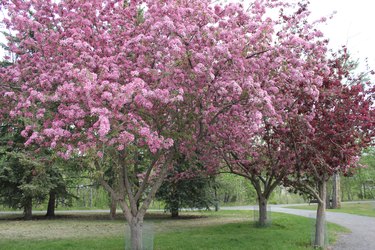
What does lilac (Syringa, USDA plant hardiness zones 3-8) look like? There are approximately 25 different species of this genus of flowering shrubs and small trees, so it can vary. As opposed to being evergreens, all lilacs are deciduous and shed their leaves annually. The main attraction is their lovely, fragrant flowers, but these can take a few years to start coming out once the lilacs are planted. Once they do, though, you'll fall in love with the fantastic scent.
What Does a Lilac Look Like?
Video of the Day
Lilac bush leaves are generally dark and green and are found on opposite sides of the stems. Most are simple with full margins, while others have compound or lobed ones. The common lilac shrub (Syringa vulgaris, zones 3-7) can grow from 12 to 16 feet high and 8 to 12 feet wide, with grayish-green to blue opposite leaves that can be ovate or heart-shaped and 2 to 5 inches long. The flowers are lilac to darker purple and bloom in the mid to late spring, growing in tubular clusters. Lilac bark on Syringa vulgaris is gray to grayish-brown.
Video of the Day
The late lilac shrub (Syringa villosa, zones 3-7) is smaller at 6 to 10 feet high and wide, with ovate to oblong medium green leaves that grow to 7 inches long. Its flowers don't smell as strong as other varieties, and they are white to rose-lilac in color. Those grow in pyramid-shaped panicles (loose, branching clusters) that can be as long as 8 inches.
Note that a "lilac tree" is a general term for numerous plants in the Syringa genus, but a tree lilac is actually its own plant, Syringa reticulata, which thrives in USDA zones 3 to 7. You'll notice that this plant has leaves that are opposite one another and of the broad-ovate to ovate variety. Typically, the leaves are between 5 and 15 centimeters in length and are about half as wide. Colorwise, the leaves are dark green above and grayish-green underneath.
Other Lilac Tree Leaves
Native to China, the early lilac (Syringa oblata, zones 3-6) tops off and out at 12 feet, and its leaves are kidney-shaped, simple, opposite and round to ovate in shape. They are heart-shaped, taper sharply at the ends, start bronze in the spring, turn greenish-blue in summer and finally become purplish-red in autumn. It is the only known species of lilac that turns such a different shade in the fall, and its flowers are dense, pinkish 2- to 5-inch panicles.
Persian lilacs (Syringa × persica, zones 4-7) grow to be 4 to 8 feet high and 5 to 10 feet wide. Persian lilac is a hybrid with uncertain parentage. It features 2.5-inch long, dark green, narrow, oval-shaped leaves that taper to points at the ends (lanceolate). They are prolific bloomers, and the pale violet, small, sweet-smelling flowers grow in 3-inch panicles.
There's also the incredible Sensation lilac (Syringa vulgaris 'Sensation,' zones 4-7), which has show-stopping, fragrant clusters with white-edged, purple blooms that can sometimes turn all white. Its leaves are medium green and heart-shaped.
Caring for Lilacs
Even though lilacs can look like trees, almost all species are shrubs. They generally have about 10 main canes branching out from a central stem that is under the ground. Most have purple or pink flowers, and these start appearing at the end of May and bloom for two weeks or so. You should plant them in the fall in areas that get a lot of direct sunlight every day.
Lilacs prefer well-draining soil with a pH that is neutral to slightly alkaline. Plant them 5 to 15 inches apart with a bit of organic compost added to the roots. They make beautiful hedges, they're low maintenance and they don't require a great deal of water. In most cases, they only need water once weekly in June and July; do not water lilac bushes in the fall or winter. If your lilac bushes are struggling with water, you can add some mulch around the roots to aid with water retention and encourage more prominent flowers.
- North Carolina State Extension: Syringa vulgaris
- North Carolina State Extension: Syringa oblata
- North Carolina State Extension: Syringa reticulata
- Britannica: Lilac
- Leafy Place: Lilac Bush: Facts, Flowers, How to Grow It and Care Tips (With Pictures)
- Missouri Botanical Garden: Syringa vulgaris
- Oregon State University: Syringa reticulata